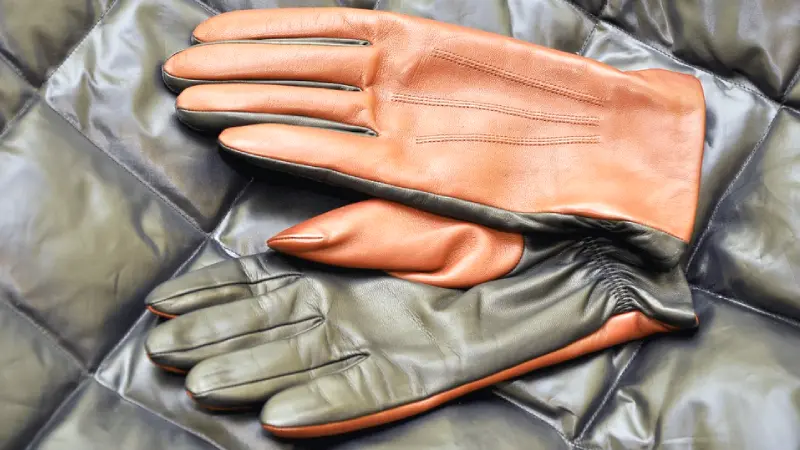How to Waterproof Leather Gloves: A Simple & Effective Guide
Leather gloves can get damaged or discolored if they are in constant contact with snow or water. When water penetrates the surface of leather, its natural oils dry off, leaving the material dry and prone to brittleness.
To avoid brittleness and cracking of your leather gloves, you should waterproof them regularly using a special waterproofing wax. This can protect and condition your leather gloves for all kinds of situations.
Waterproofing them is essential in ensuring a long lifespan. We recommend waterproofing all types of leather gloves, particularly when used for skiing, hiking, working, and most other outdoor activities.
Here is a quick summary of how to waterproof leather gloves in just four easy-to-follow steps:
- Clean Your Leather Gloves
- Apply a Waterproofing Wax
- Remove Access Product
- Let Your Leather Gloves Dry Naturally
This guide is designed to teach you how to waterproof your leather gloves, as well as share some of the best practices when following this process. We’ve also made sure to share more details on why you should waterproof them and have included a section where we answer some of the most frequently asked questions.
Why Should You Waterproof Your Leather Gloves?
Waterproofing leather gloves can help protect it from foreign elements such as dirt, dust, and accidental water splashes. These elements can penetrate and damage the internal leather fibers, which can ruin the quality and appearance of your leather gloves.
Waterproofing is recommended for all types of gloves since they can all be exposed to elements such as snow, water, rain, sweat, and moisture. It’s particularly recommended for leather gloves that are used for outdoor activities such as:
- Skiing
- Hiking
- Hunting
- Camping
- Working
- Biking
A waterproofing wax layer enhances the water repellency of the leather material of your leather gloves while maintaining its natural breathability.
Since wax is naturally a hydrophobic compound, it helps to repel water particles instead of absorbing them. This preserves the texture and color of your leather gloves for a long time.
Before you start the waterproofing process, ensure that you have the following items and products ready:
- 2 x Soft Cloth
- 1 x Leather Cleaning Solution
- 1 x Leather Waterproofing Wax
1. Clean Your Leather Gloves
Before applying any type of waterproofing wax to your leather gloves, you’ll need to ensure that they are clean. Without properly cleaning dirt, stains, and grime from your leather gloves, you will trap the impurities in the leather pores, which will affect their breathability.
Moreover, trapping dirt and bacteria underneath a waterproofing layer can also lead to the buildup of mold and mildew. To begin cleaning, take a clean, lightly damp cloth and apply some saddle soap to your leather gloves.
Then, proceed to rub the saddle soap in small circular motions over the entire surface of the leather gloves. Ensure to only use moderate pressure and apply an even layer.
Let the saddle soap set for a couple of minutes and wipe away any excess product using a dry cloth. The saddle soap helps to remove any types of impurities and also helps to condition the leather surface.
Additional Tip: While you’re cleaning the exterior leather material of your gloves, it also makes sense to clean the interior lining using a gentle soap. While this is not required to waterproof your leather gloves, it’s good practice.
2. Apply a Waterproofing Wax
This is where the magic happens! A waterproofing wax will help to protect your leather gloves against water damage, due to exposure to water or moisture.
Having tested hundreds of products over the years, our favorite waterproofing wax for leather gloves is the Nikwax Waterproofing Wax. This product is water-based and also biodegradable, containing no harmful or toxic substances.
How to Apply A Waterproofing Wax onto Your Leather Gloves
Applying a layer of waterproofing wax to your leather gloves is simple and straightforward. Simply start by applying some waterproofing wax onto the leather of your gloves with a dry and clean cloth.
Here, it’s important to use a good combination and circular, as well as back-and-forth motions, to ensure that the entire leather surface is evenly coated.
Also, ensure to use even pressure while rubbing in the product, and remember to apply the wax in all nooks and crannies. You should now have an even-coated and light layer of wax on your leather gloves.
3. Remove Excess Product
Now, you’ll need to remove any excess wax from your leather gloves. Do this by taking a clean cloth and wiping away any excess wax. Leaving on too much wax can lead to darker spots in certain areas and also cause inconsistent water repellency.
4. Let Your Leather Gloves Dry Naturally
After having added a waterproofing layer to your leather gloves, you should allow them to dry in an airy and well-ventilated space. An ample resting time will help the leather absorb the wax entirely before use. Let your leather gloves rest for about 24 hours for the best results.
Important Notice: Never dry your leather gloves under direct sunlight since that can lead to fading and brittleness. It can also dry up the wax before your leather gloves are able to fully absorb it.
Here are some ideas where you can dry your leather gloves:
- On a table
- In front of a fan
- On the balcony
- Under a shaded verandah
- On the patio
Allowing your leather gloves to dry naturally gives them enough time to absorb the wax, in order to create an effective waterproofing layer, without compromising breathability.
Frequently Asked Questions
In this section, we’ll be answering some of your most frequently asked questions about waterproofing your leather gloves. If you would like to have your question answered, please feel free to reach out to us.
What Type of Leather Gloves Should I Waterproof?
All leather gloves that may be exposed to liquids, food, or moisture should be waterproofed. Leather gloves that you plan to wear in the rain, snow, or around any water body should also be waterproofed for protection.
We generally recommend waterproofing for all kinds of leather gloves, such as:
- Leather Ski Gloves
- Leather Hiking Gloves
- Leather Backpacking Gloves
- Leather Work Gloves
- Leather Hunting Gloves
- Leather Winter Gloves
- Leather Motorcycle Gloves
- General Leather Gloves
How Often Should I Waterproof My Leather Gloves?
The answer to this question depends on your use and how often your leather gloves come in contact with water, snow, or moisture. Leather ski gloves are recommended to be waterproofed about two to three times in the winter season, while some leather gloves only need to be waterproofed once a year.
We recommend waterproofing leather gloves once or twice a year, at the beginning of the winter season and its end, before carefully storing them.
You should also consider waterproofing your leather gloves if you live in an area with high or fluctuating humidity levels. Humidity can cause irreversible damage to leather and should be protected with a wax layer whenever possible.
What Is the Best Waterproofing Wax?
There are a variety of waterproofing waxes on the market, but you should always choose the one compatible with your leather product. Most waterproofing formulas consist of waxes, but some brands also add dubious and harmful ingredients.
You should always read about the ingredients of your waterproofing wax of choice carefully before use, to avoid damaging your leather gloves unknowingly.
We recommend using Nikwax Waterproofing Wax for Leather since it delivers excellent results for leather gloves. Our Nikwax Waterproofing Wax for Leather Review details how you can use this wax correctly and what waterproofing and conditioning benefits it can offer to your leather gloves.

About Gerrit
Co-Founder, Researcher & Writer At Leatherskill
I’m a leather enthusiast who spends most of his free time crafting, researching, and writing about the many facets of this versatile material. Thanks for reading!

